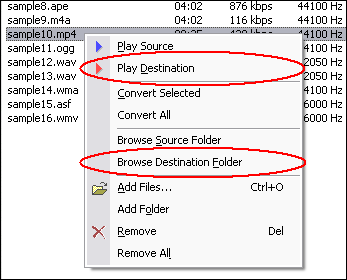MLP to AACConvert MLP to AAC, MLP to AAC Converter |
 |
| Home | Getting Started | Download | Buy Now! | Screen Shots | FAQ | Support | Contact |
MLP to AAC software converts MLP to AAC. The software is an ALL-IN-ONE audio converter that supports more than 90 audio and video files. MLP to AAC software supports batch conversion and is full compatible with Vista and Windows 7.
MLP to AAC software is 100% clean and safe to install.
It's certified by major download sites. What is MLP? The MLP is used by Meridian codec. Audio compression used on DVD video discs. MLP performs lossless compression of up to 63 audio channels including 24-bit material sampled at rates as high as 192kHz. Lossless compression has many applications in the recording and distribution of audio. In designing MLP we have paid a lot of attention to the application of lossless compression to data-rate-limited ransmission (e.g. storage on DVD), to the option of constant data rate in the compressed domain and to aspects that impact on mastering and authoring. MLP was targeted to provide:
MLP provides for up to 63 channels, but applications tend to be limited by the available data rate. To aid compatibility, MLP uses a hierarchical stream structure containing multiple substreams and hierarchical additional data. With this stream structure decoders need only access part of the stream to playback subsets of the audio. Suitable use of the substreams also allows 2-channel compatibility; a low-complexity decoder can recover a stereo mix from a multichannel stream. Figure 1 gives an overview of the process of losslessly compressing a stream containing multiple audio channels and auxiliary data onto a disc. What is AAC? AAC has been standardized by ISO and IEC, as part of the MPEG-2 & MPEG-4 specifications. The MPEG-2 standard contains several audio coding methods, including the MP3 coding scheme. AAC is able to include 48 full-bandwidth (up to 96 kHz) audio channels in one stream plus 15 low frequency enhancement (LFE, limited to 120 Hz) channels and up to 15 data streams. AAC is able to achieve indistinguishable audio quality at data rates of 320 kbit/s (64kbit/s/channel) for five channels. The quality is close to CD also at 96 kbit/s (48kbit/s/channel) for stereo. AAC's best known use is as the default audio format of Apple's iPhone, iPod, iTunes, and the format used for all iTunes Store audio (with extensions for proprietary digital rights management). AAC is also the standard audio format for Sony's PlayStation 3 and is supported by Sony's Playstation Portable, latest generation of Sony Walkman, Sony Ericsson Walkman Phone, Nintendo's Wii (with the Photo Channel 1.1 update installed for Wii consoles purchased before late 2007) and the MPEG-4 video standard. HE-AAC is part of digital radio standards like DAB+ and Digital Radio Mondiale. Convert MLP to AAC Related Topics: F4A to AAC, GSM to AAC, GXF to AAC, MJ2 to AAC, PSX to AAC, PVA to AAC, QCP to AAC, ROQ to AAC, ULAW to AAC, VFW to AAC, VID to AAC, VMD to AAC, ALAC to AAC, AMR to AAC, AVI to AAC, CDA to AAC, FLAC to AAC, IT to AAC, MPC to AAC, MTM to AAC, OGA to AAC, WMA to AAC, WMV to AAC, WV to AAC, EVOB to AAC, FLV to AAC, M2V to AAC, MKV to AAC, MMF to AAC, OGM to AAC, OGV to AAC, CD to AAC, SWF to AAC, VOB to AAC, VOC to AAC, WMD to AAC, XVID to AAC
|
| Home | Getting Started | Download | Buy Now! | Screen Shots | FAQ | Support | Contact | Links |
| Copyright © 2008-2017 Hoo Technologies All rights reserved. Privacy Policy |






